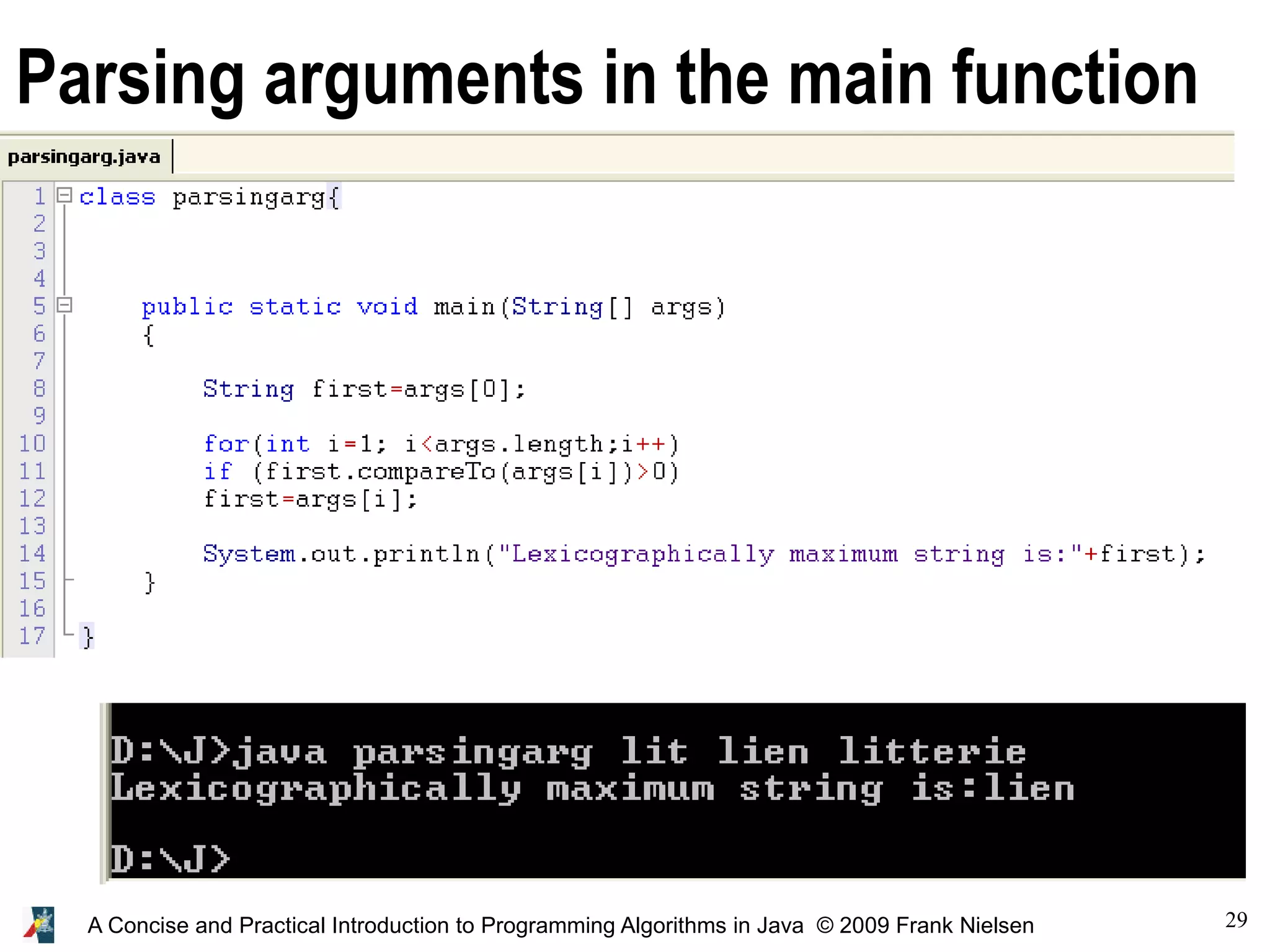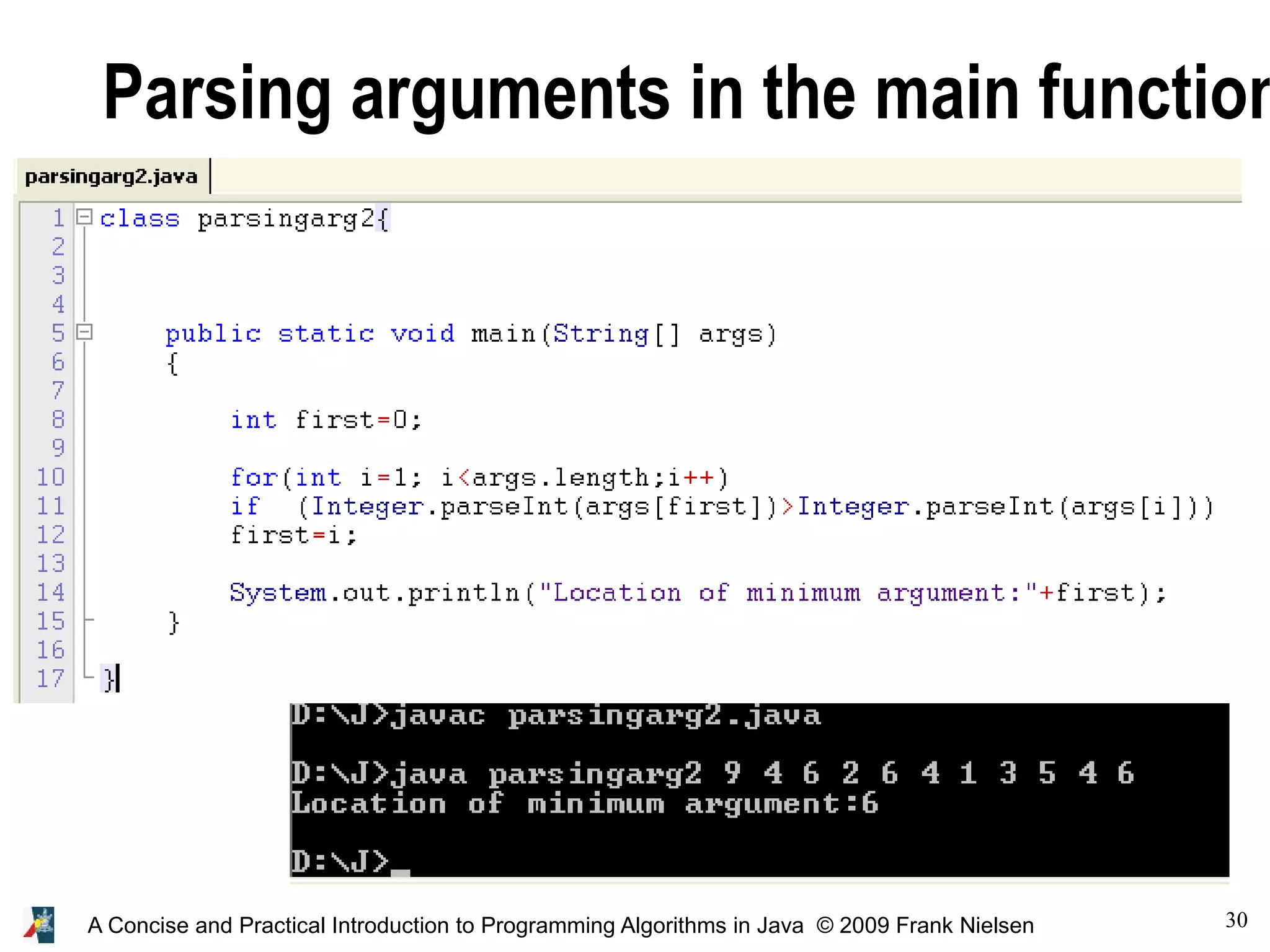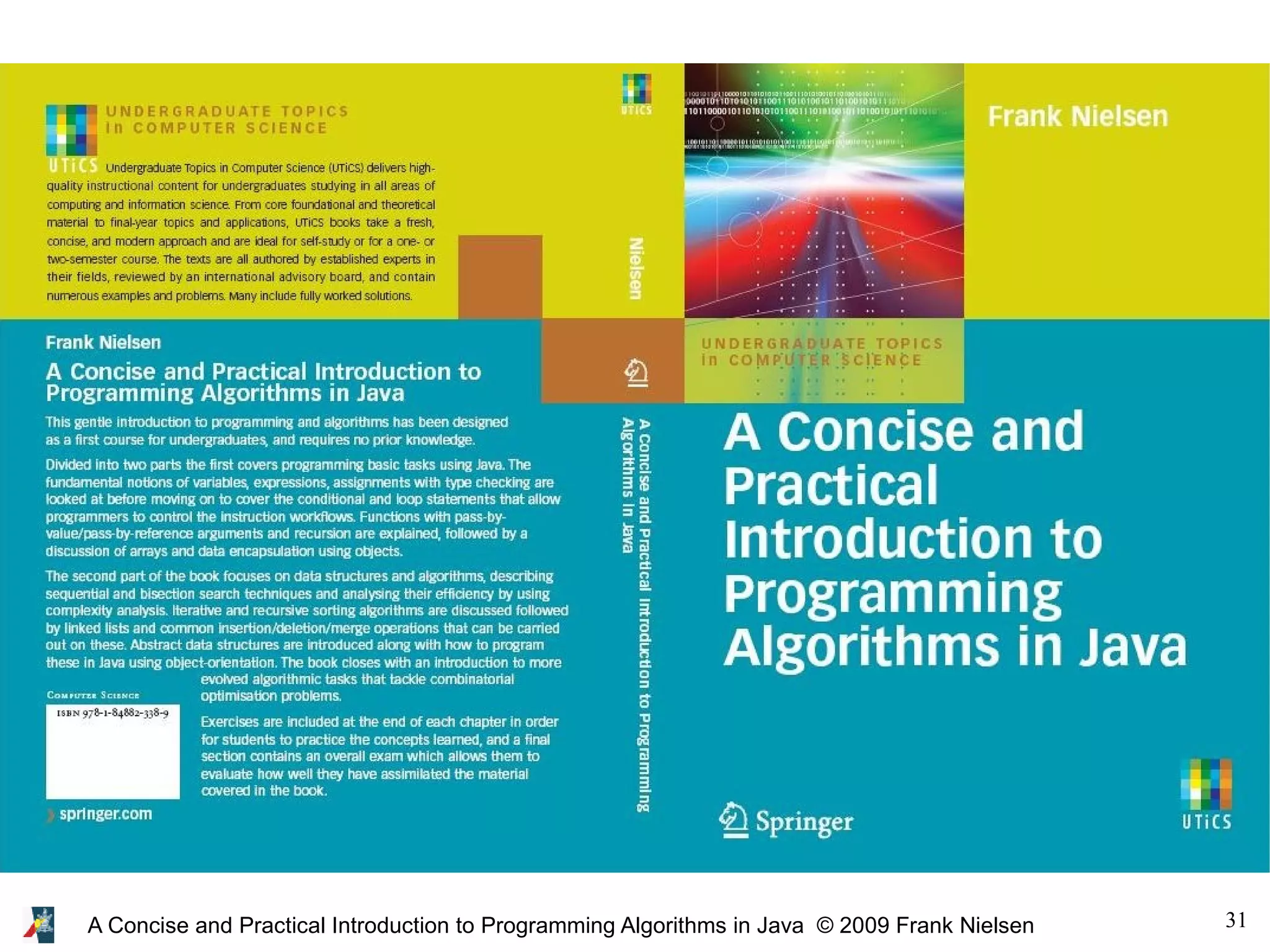The document is an introduction to programming algorithms in Java, focusing on arrays and strings. It discusses array declarations, initialization, size, index range, exceptions, and references, alongside examples of functions that use arrays. It also covers two-dimensional arrays and basic string operations, highlighting important methods and the use of the main function with command-line arguments.
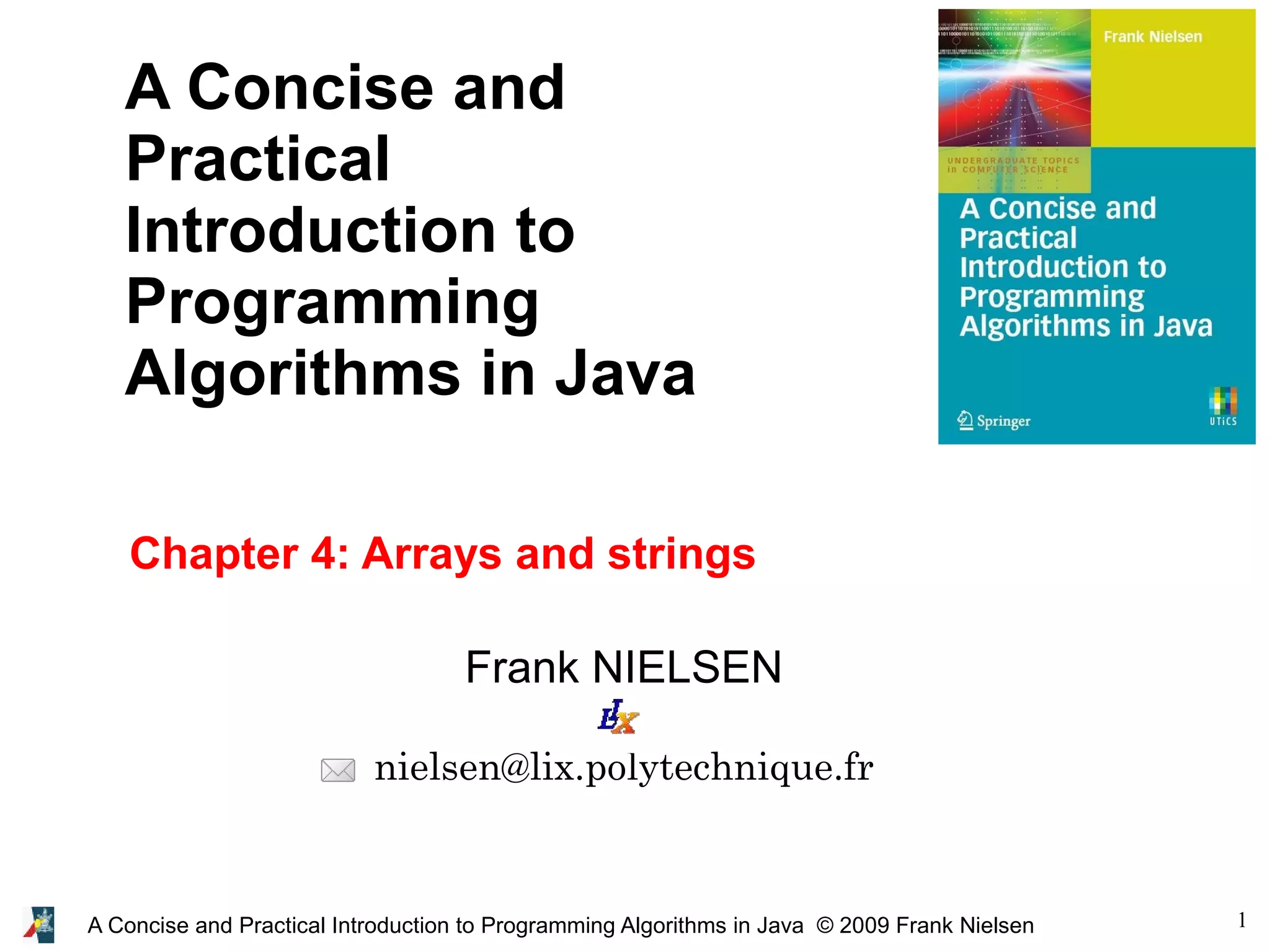
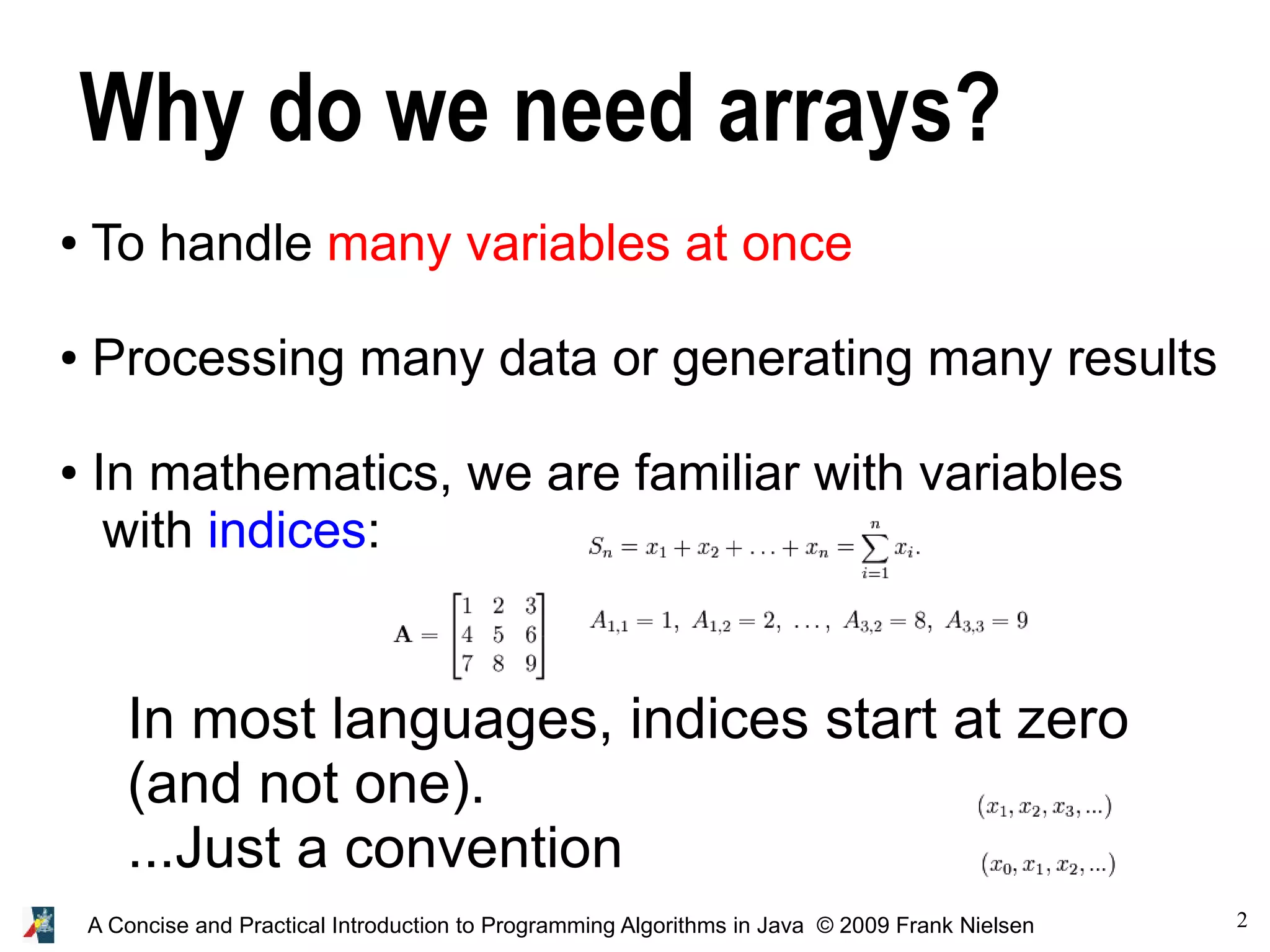
![3A Concise and Practical Introduction to Programming Algorithms in Java © 2009 Frank Nielsen Declaring arrays in Java For a given type, TYPE[ ] is the type of arrays storing elements of type TYPE. ● For arrays declared within the scope of functions: ● int [ ] x; ● boolean [ ] prime; ● double [ ] coordinates; ● float [ ] [ ] matrix; ● For arrays declared in the body of a class, use the keyword static: (array variables can be used by any function of the class) ● static int [ ] x; ● static boolean [ ] prime;](https://image.slidesharecdn.com/programmingalgorithmsjava-4-140701005341-phpapp02/75/chapter-4-A-Concise-and-Practical-Introduction-to-Programming-Algorithms-in-Java-3-2048.jpg)
![4A Concise and Practical Introduction to Programming Algorithms in Java © 2009 Frank Nielsen Building and initializing arrays Observe: static boolean prime[ ]={ false, true, true, true, false, true, false, true, false, false }; but not static boolean prime[10]={ false, true, true, true, false, true, false, true, false, false };](https://image.slidesharecdn.com/programmingalgorithmsjava-4-140701005341-phpapp02/75/chapter-4-A-Concise-and-Practical-Introduction-to-Programming-Algorithms-in-Java-4-2048.jpg)
![5A Concise and Practical Introduction to Programming Algorithms in Java © 2009 Frank Nielsen Building and initializing arrays ● Declare array with the reserved keyword new ● Specify the size of the array at built time ● Arrays can be declared and initialized at once too: ● int [ ] x; ● x=new int [32]; ● boolean [ ] prime = new boolean[16]; ● Arrays initialized by enumerating all its values: int [ ] prime={2, 3, 5, 7, 11, 13, 17, 19};](https://image.slidesharecdn.com/programmingalgorithmsjava-4-140701005341-phpapp02/75/chapter-4-A-Concise-and-Practical-Introduction-to-Programming-Algorithms-in-Java-5-2048.jpg)
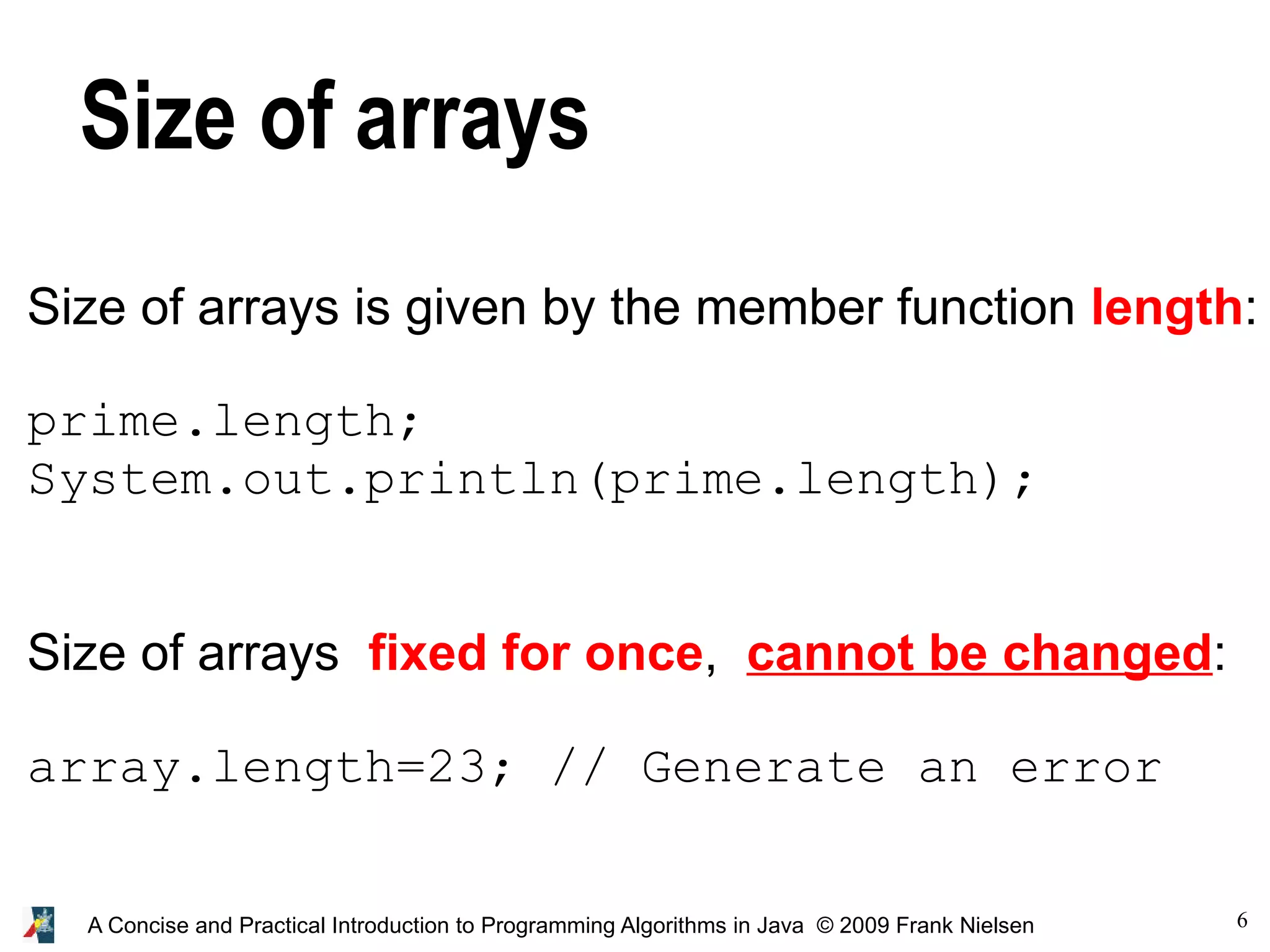
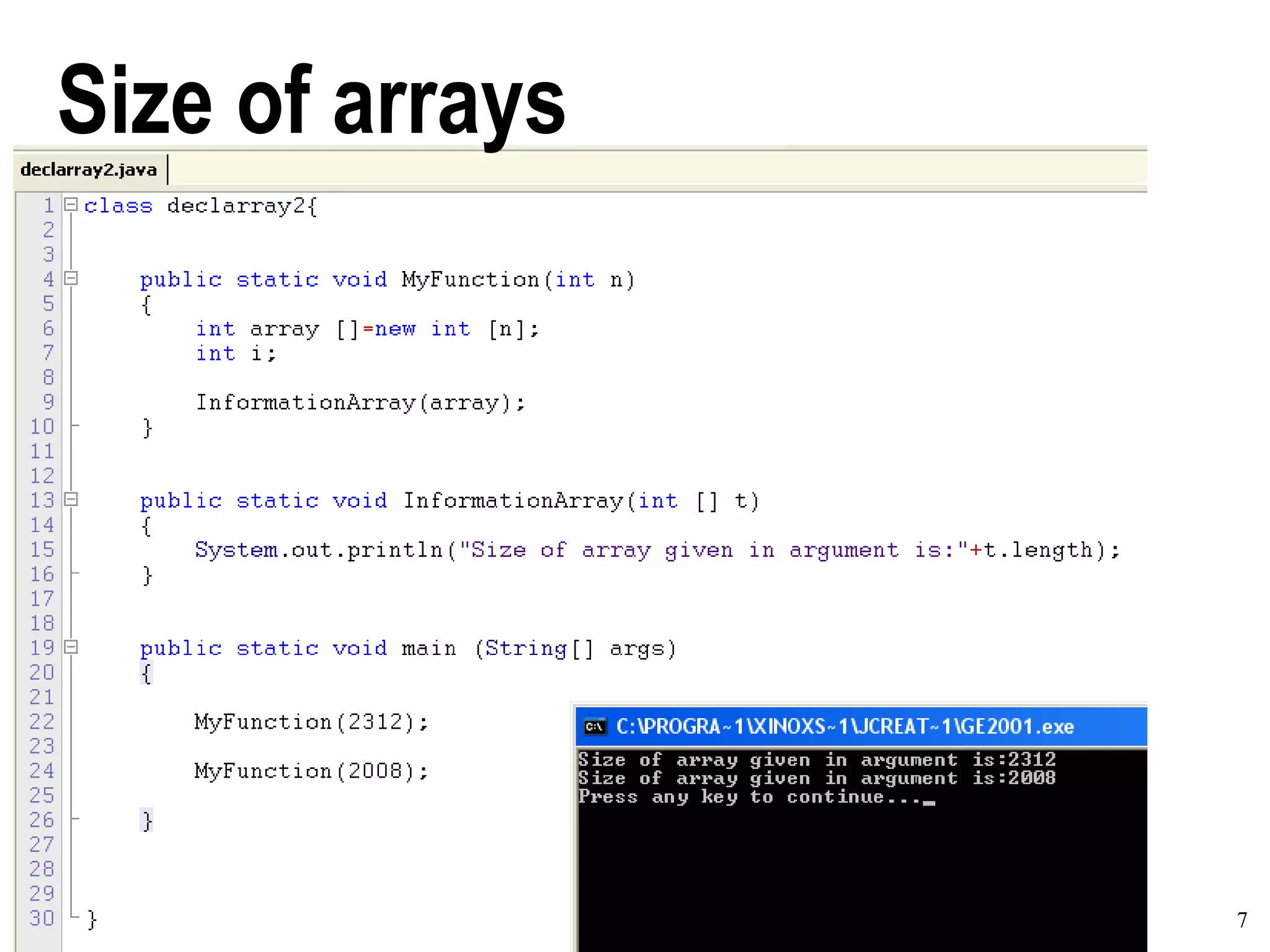
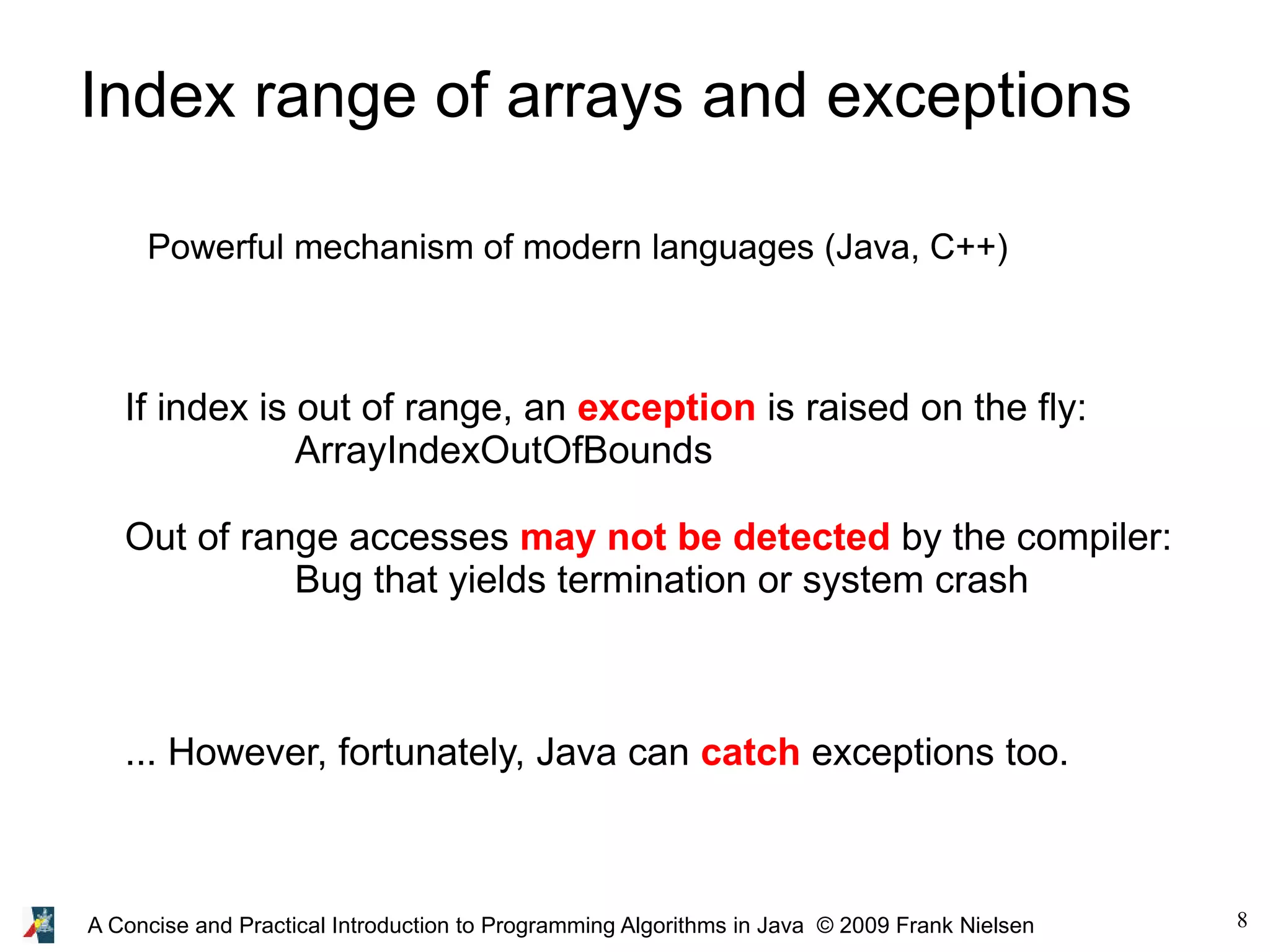
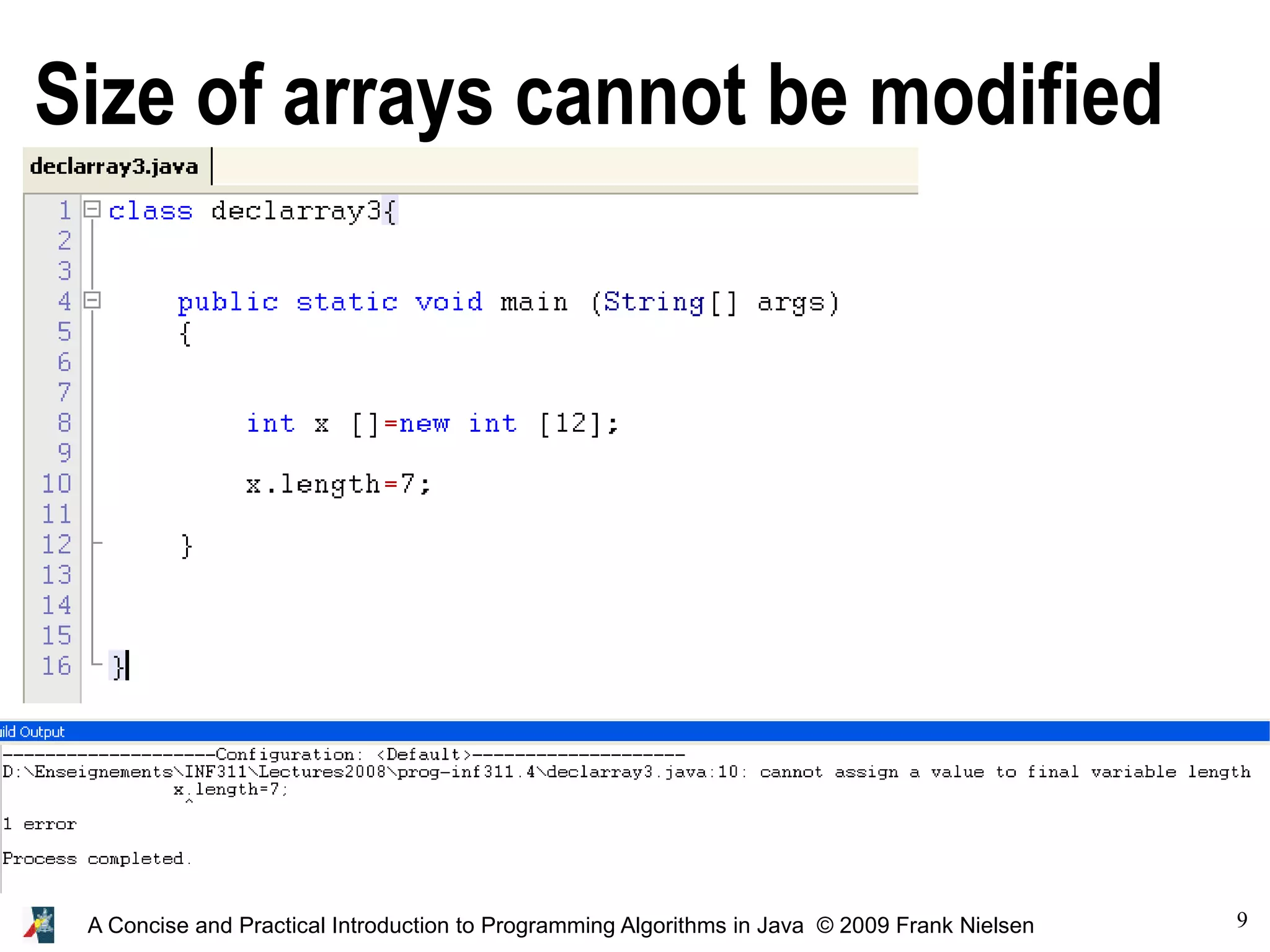
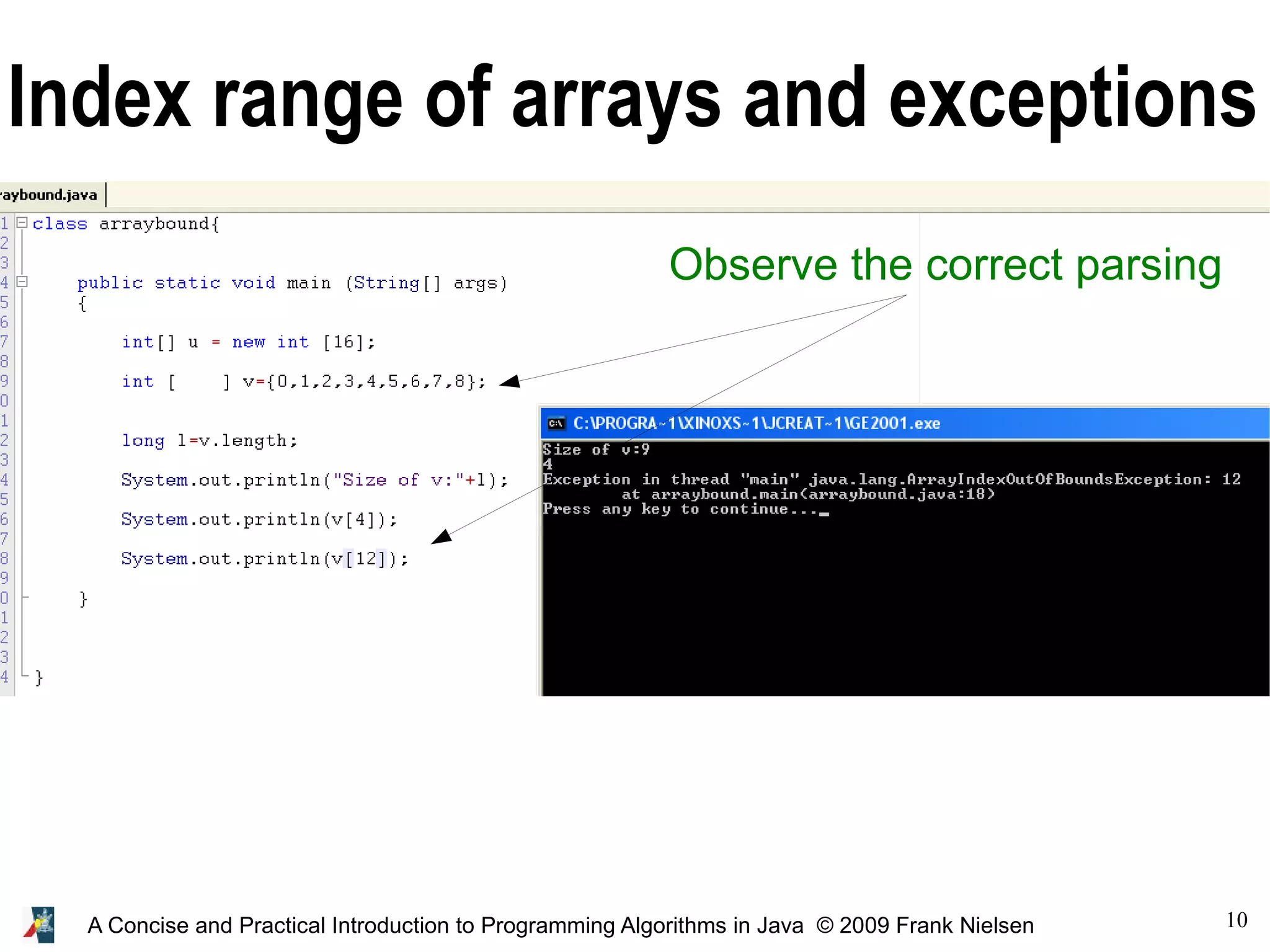
![11A Concise and Practical Introduction to Programming Algorithms in Java © 2009 Frank Nielsen The concept of references An array is allocated as a single contiguous memory block Java is managing memory so you do not have to free it once the array is not used anymore: garbage collector An array variable is, in fact, a reference to the array This reference of the array is the symbolic address of the first element (index 0) Thus, when we write... int [ ] v = {0, 1, 2, 3, 4}; int [ ] t =v; t[2]++; System.out.println(t[2]++); ... the elements of the array v are not copied verbatim to t. Only the reference!!!](https://image.slidesharecdn.com/programmingalgorithmsjava-4-140701005341-phpapp02/75/chapter-4-A-Concise-and-Practical-Introduction-to-Programming-Algorithms-in-Java-11-2048.jpg)
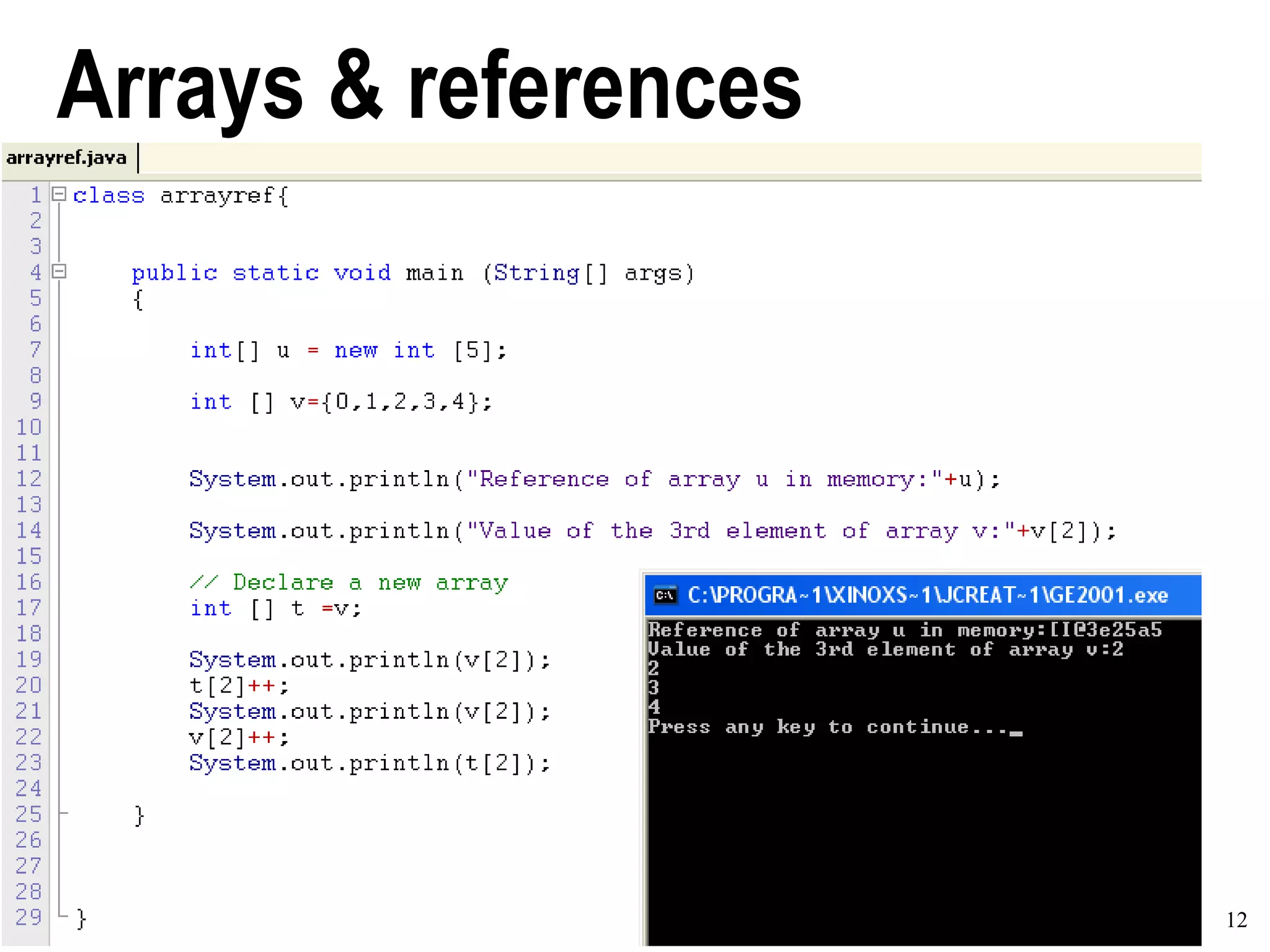
![13A Concise and Practical Introduction to Programming Algorithms in Java © 2009 Frank Nielsen Functions & arrays Functions and procedures can have arrays as arguments. (remember that array types are: TypeElement[ ]) Example: Function that returns the minimum of an array of integers](https://image.slidesharecdn.com/programmingalgorithmsjava-4-140701005341-phpapp02/75/chapter-4-A-Concise-and-Practical-Introduction-to-Programming-Algorithms-in-Java-13-2048.jpg)
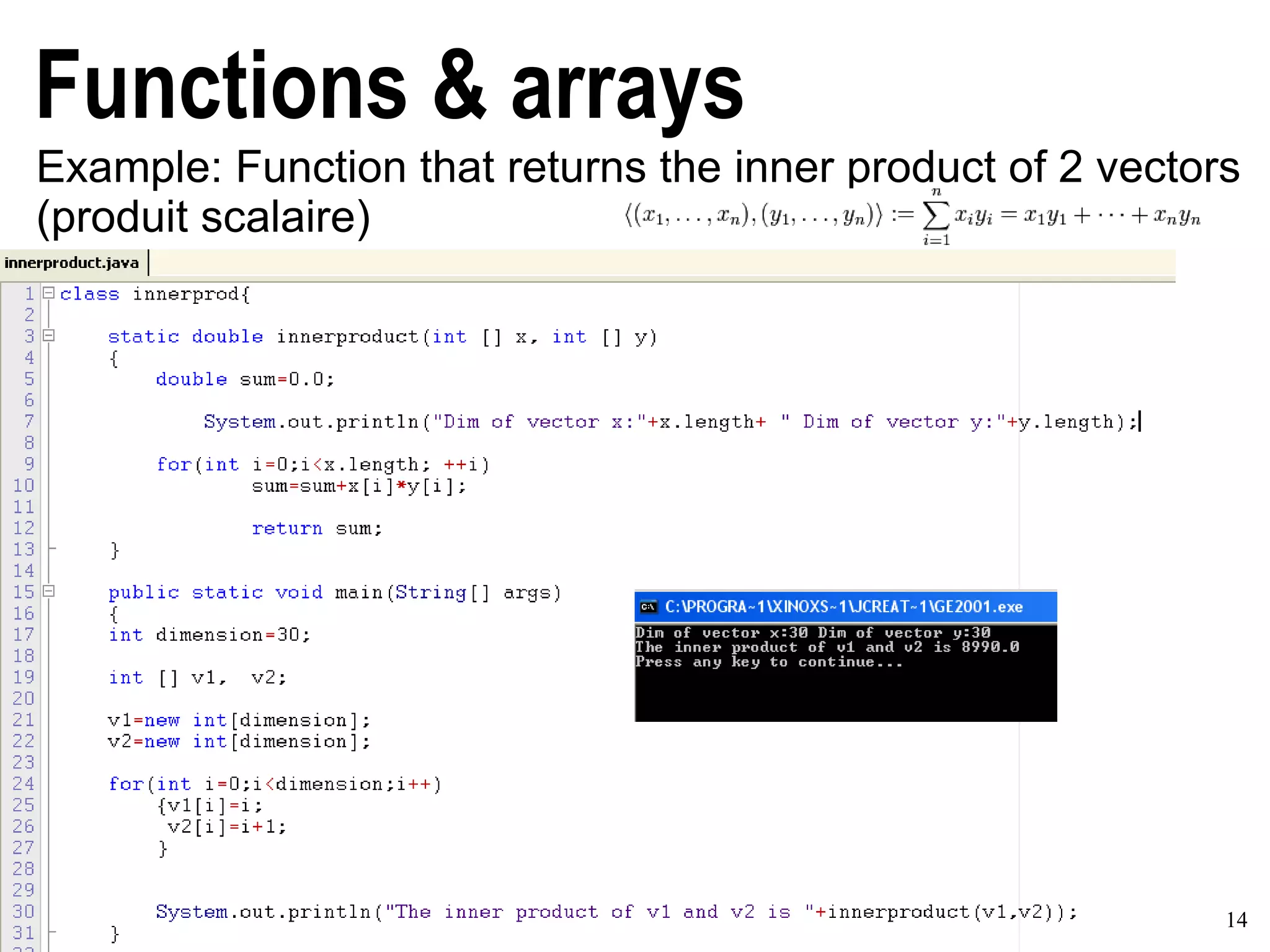
![15A Concise and Practical Introduction to Programming Algorithms in Java © 2009 Frank Nielsen Array arguments in functions A variable that has a type array is a reference to the array (the memory address of the first element) Therefore an argument of type array does not copy all array elements in the memory allocated for the function, but rather allocate a single memory reference: a machine word. static void MyFunction(int [ ] x) MyFunction(v); Only the reference of v is copied to the memory allocated for the function MyFunction.](https://image.slidesharecdn.com/programmingalgorithmsjava-4-140701005341-phpapp02/75/chapter-4-A-Concise-and-Practical-Introduction-to-Programming-Algorithms-in-Java-15-2048.jpg)
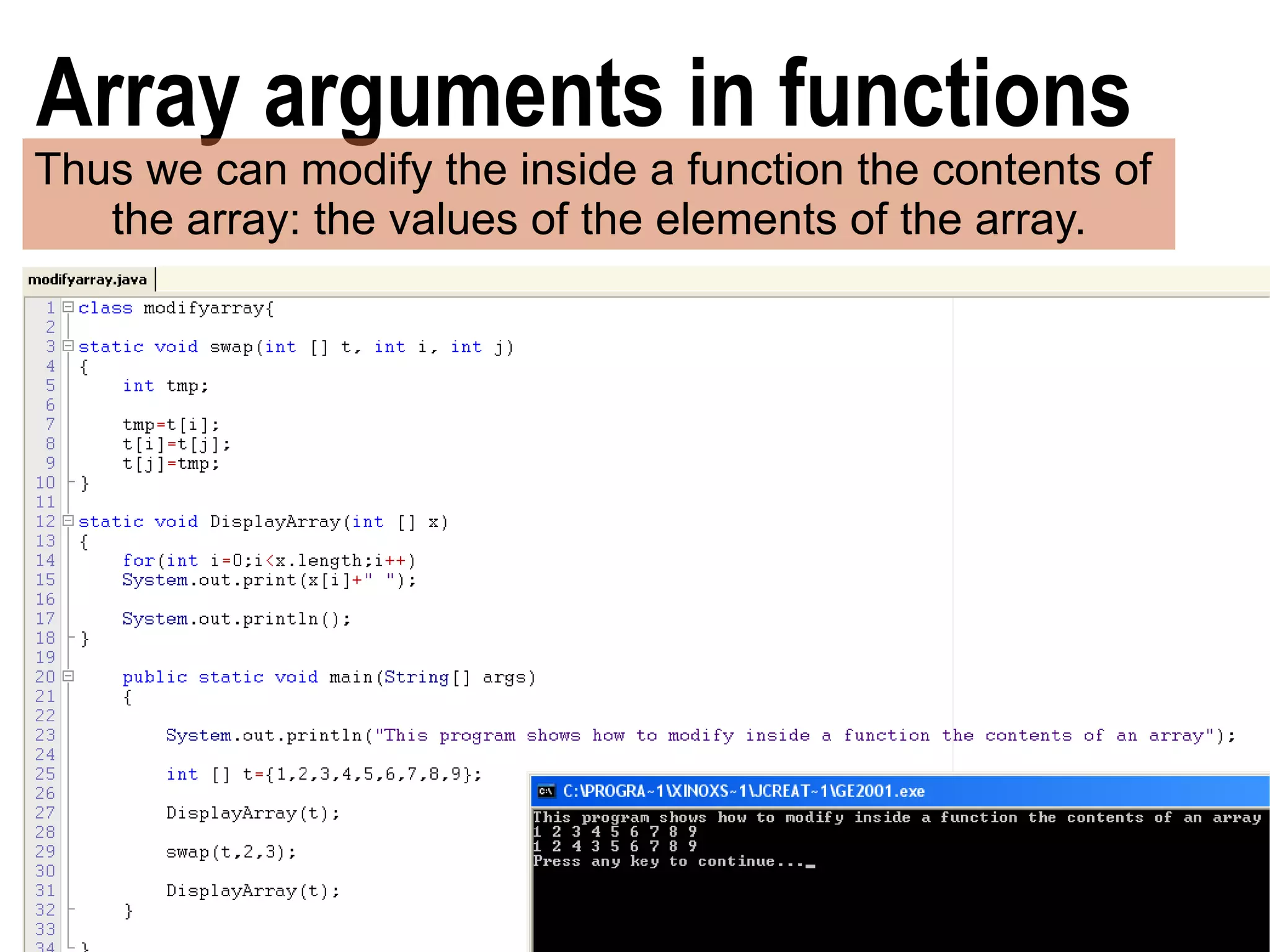
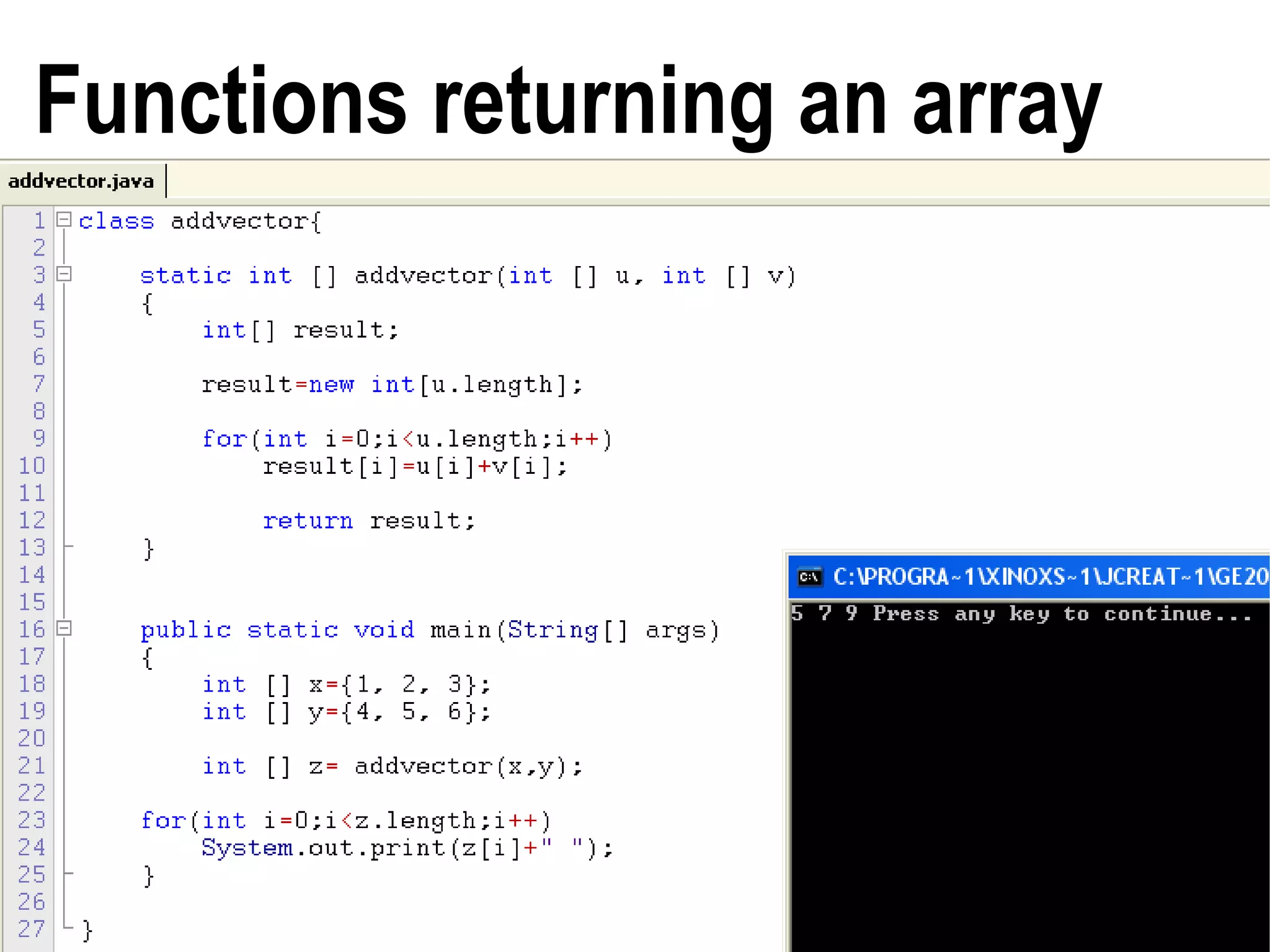
![18A Concise and Practical Introduction to Programming Algorithms in Java © 2009 Frank Nielsen Arrays of arrays... So far, we described linear array (1D). What about matrices (2D arrays)? A bidimensional array (n,m) consists of n lines, each of which is an array of m elements int [ ] [ ] matrix; matrix=new int[n][m]; By default, at initialization, the array is filled up with zero Change the contents of 2D arrays using 2 nested loops: for(int i=0; i<n; i++) for(int j=0; j<m;j++) matrix[i][j]=i*j+1;](https://image.slidesharecdn.com/programmingalgorithmsjava-4-140701005341-phpapp02/75/chapter-4-A-Concise-and-Practical-Introduction-to-Programming-Algorithms-in-Java-18-2048.jpg)
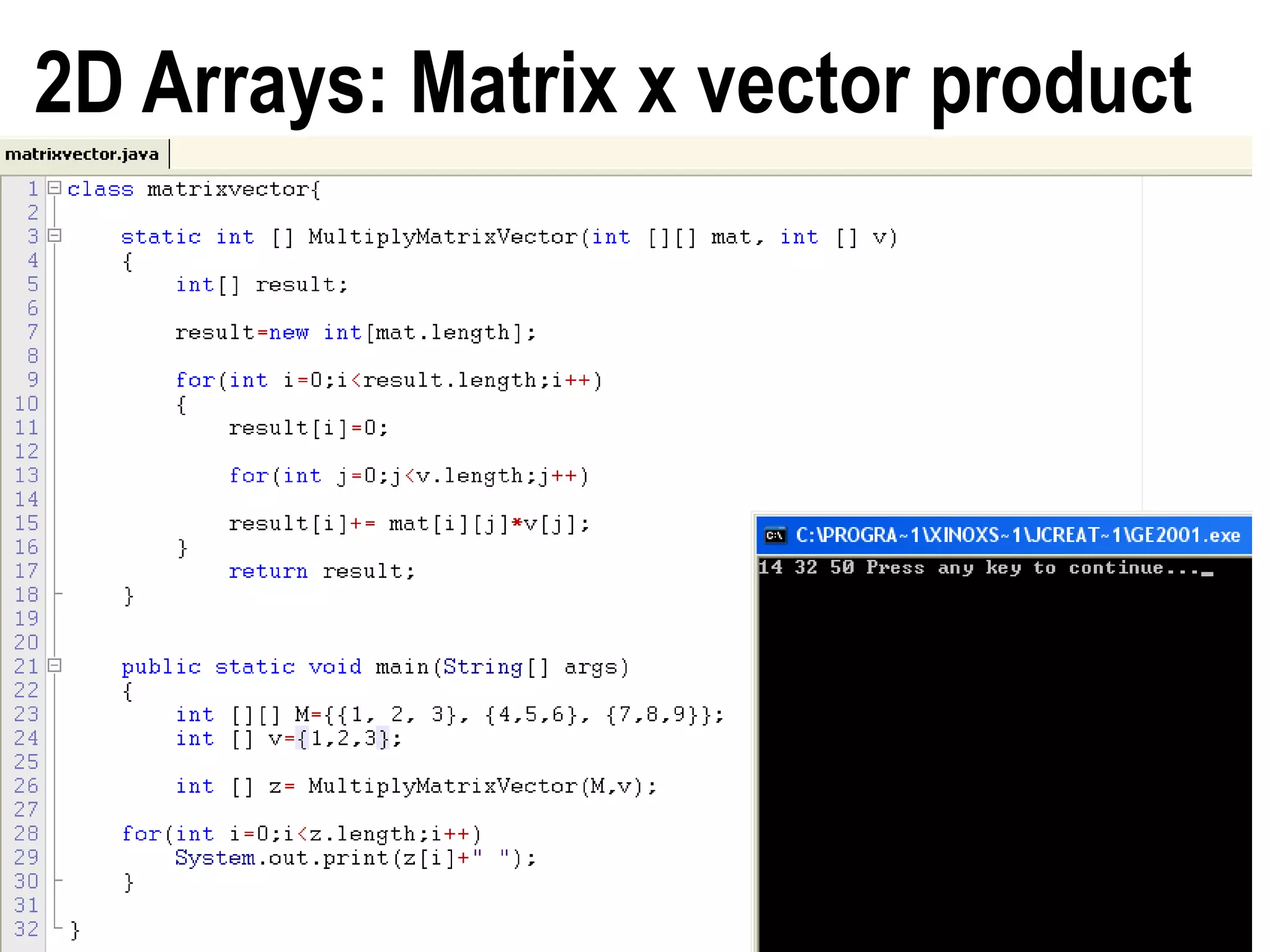
![20A Concise and Practical Introduction to Programming Algorithms in Java © 2009 Frank Nielsen Dichotomic search Also called binary search algorithm Assume we are given a sorted array of size n: array[0] < array[1] < ... < array[n-1] and a query key p Seek whether there is an element in the array that has value p That is, give a function that return the index of the element in the array with value p, or that returns -1 otherwise.](https://image.slidesharecdn.com/programmingalgorithmsjava-4-140701005341-phpapp02/75/chapter-4-A-Concise-and-Practical-Introduction-to-Programming-Algorithms-in-Java-20-2048.jpg)
![21A Concise and Practical Introduction to Programming Algorithms in Java © 2009 Frank Nielsen Dichotomic search: Think recursion! ● Start with a search interval [left, right] with left=0 and right=n-1 ● Let m denote the middle of this interval: m=(left+right)/2 ● If array[m]=p then we are done, and we return m; ● If array[m] <a, then if the solution exists it is in [m+1,right] ● If array[m]>a, then if the solution exists it is in [left,m+1] ● The search algorithm terminates if left>right, we return -1;](https://image.slidesharecdn.com/programmingalgorithmsjava-4-140701005341-phpapp02/75/chapter-4-A-Concise-and-Practical-Introduction-to-Programming-Algorithms-in-Java-21-2048.jpg)
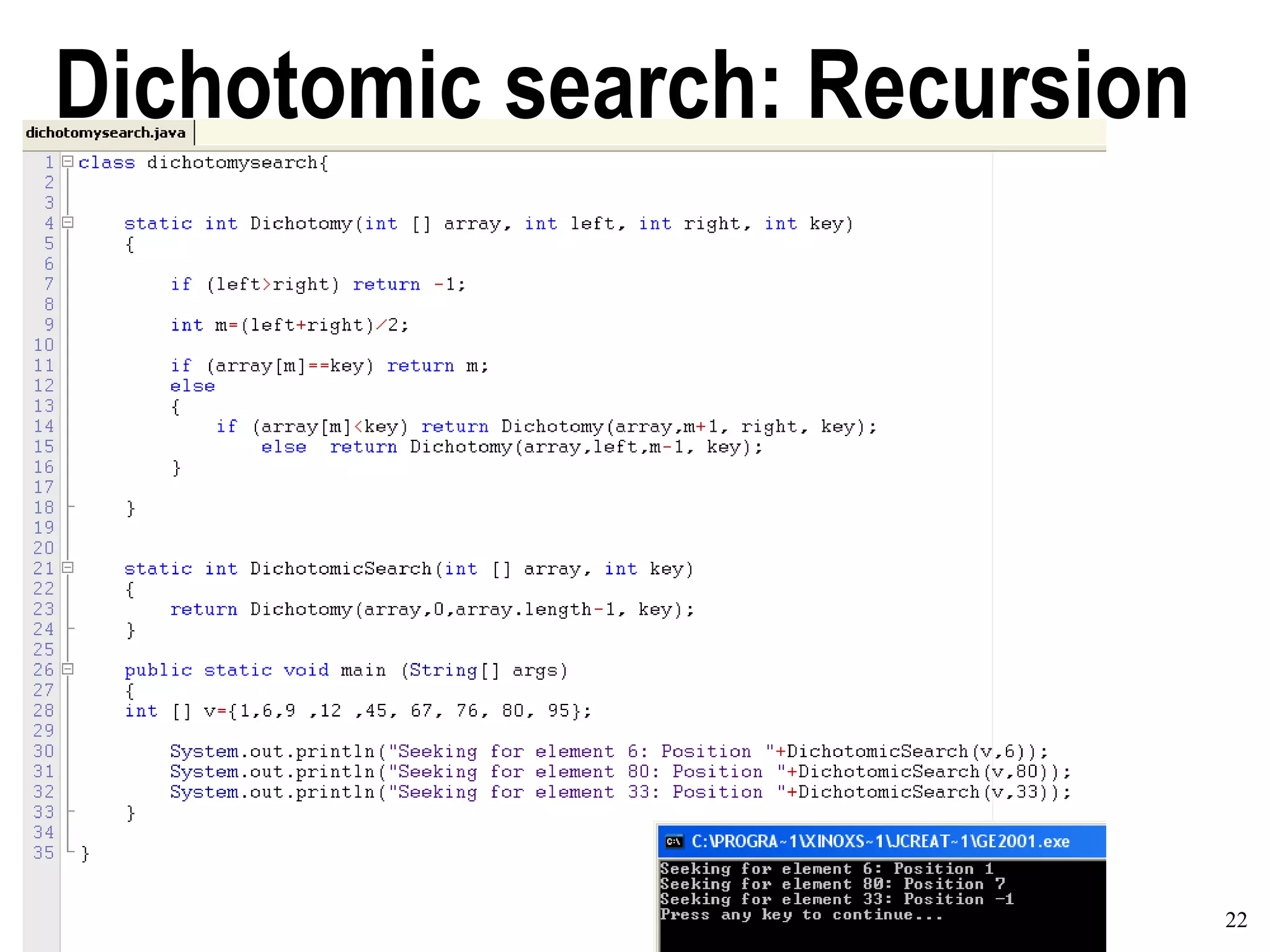
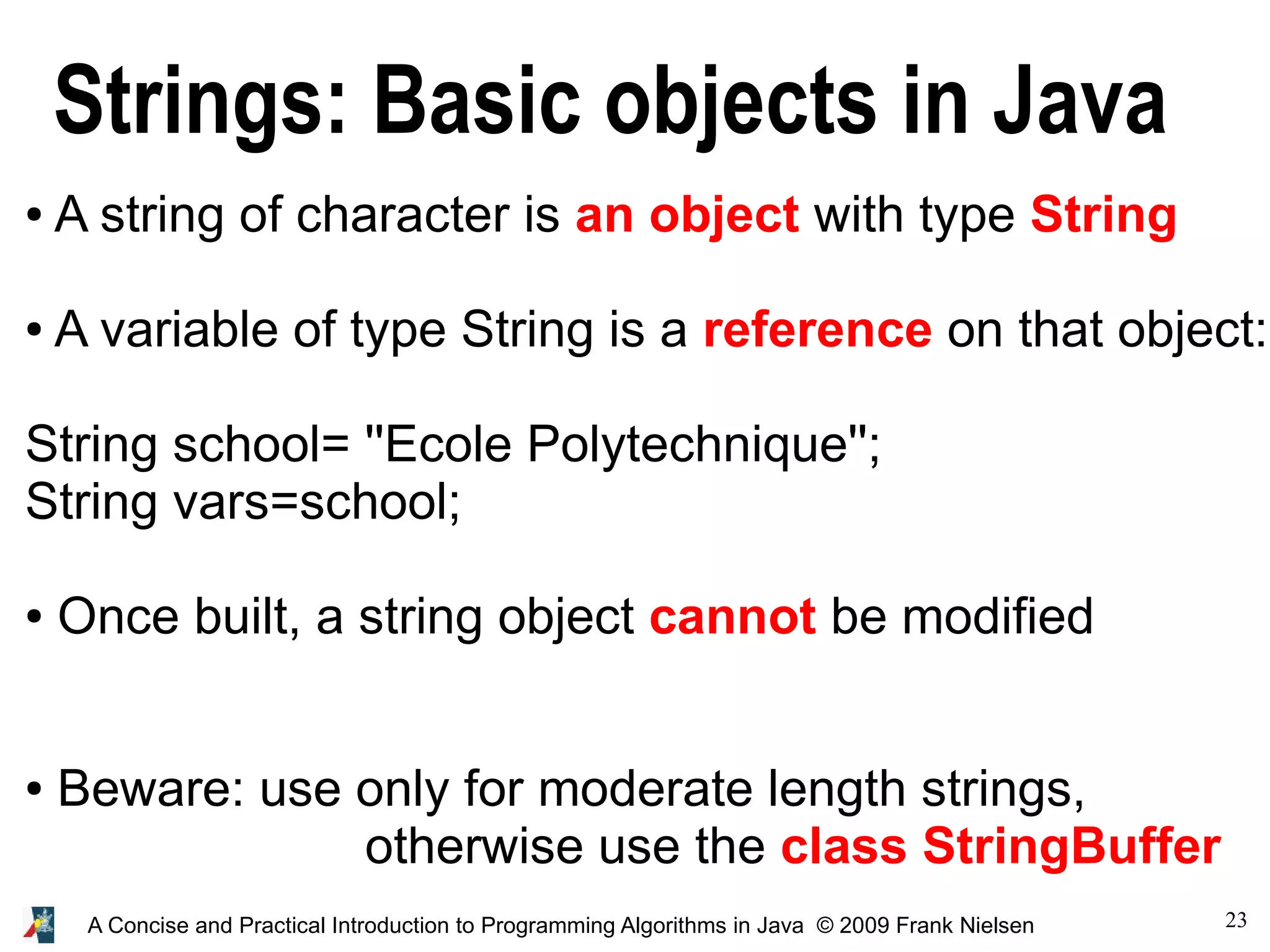
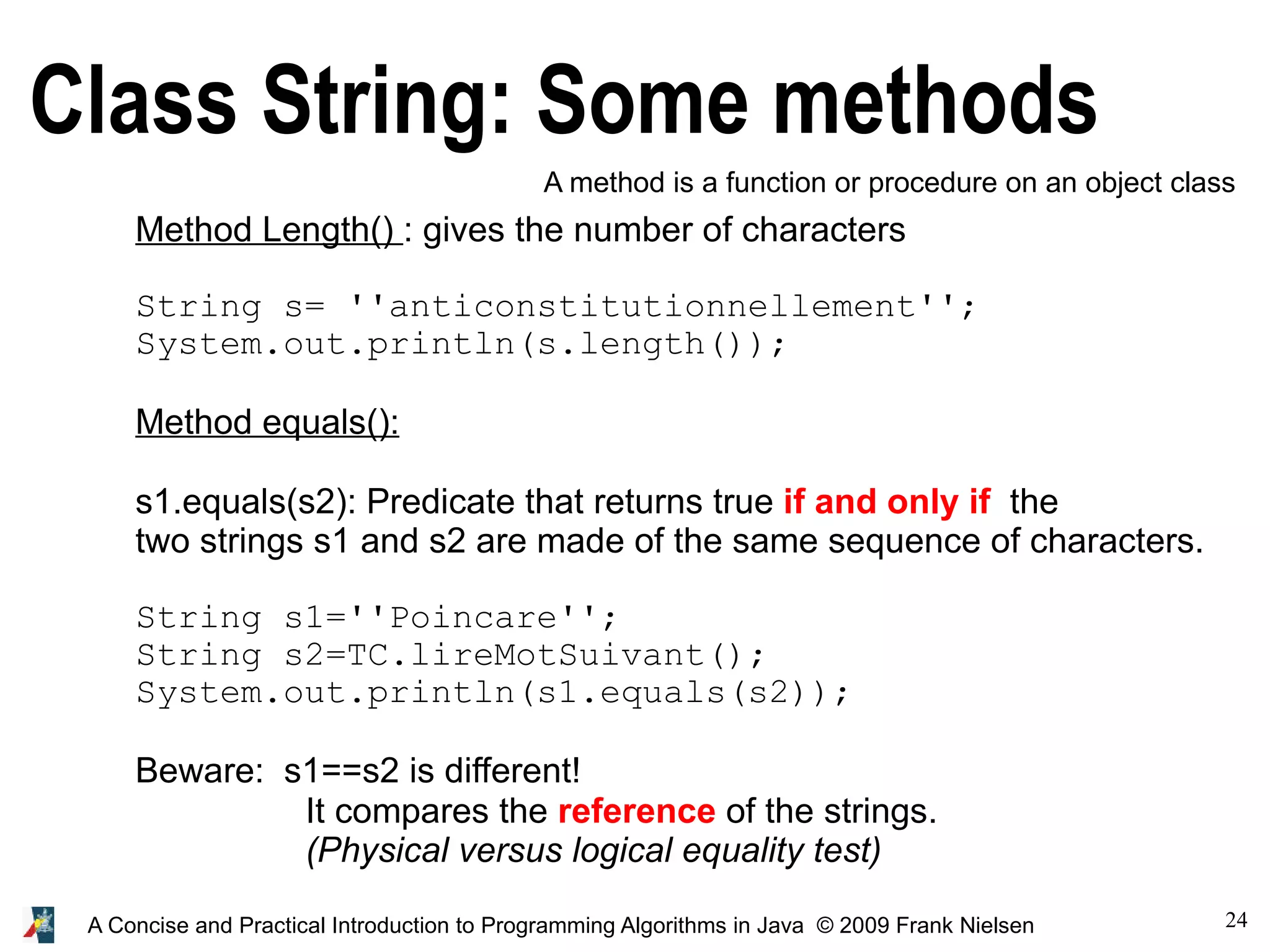
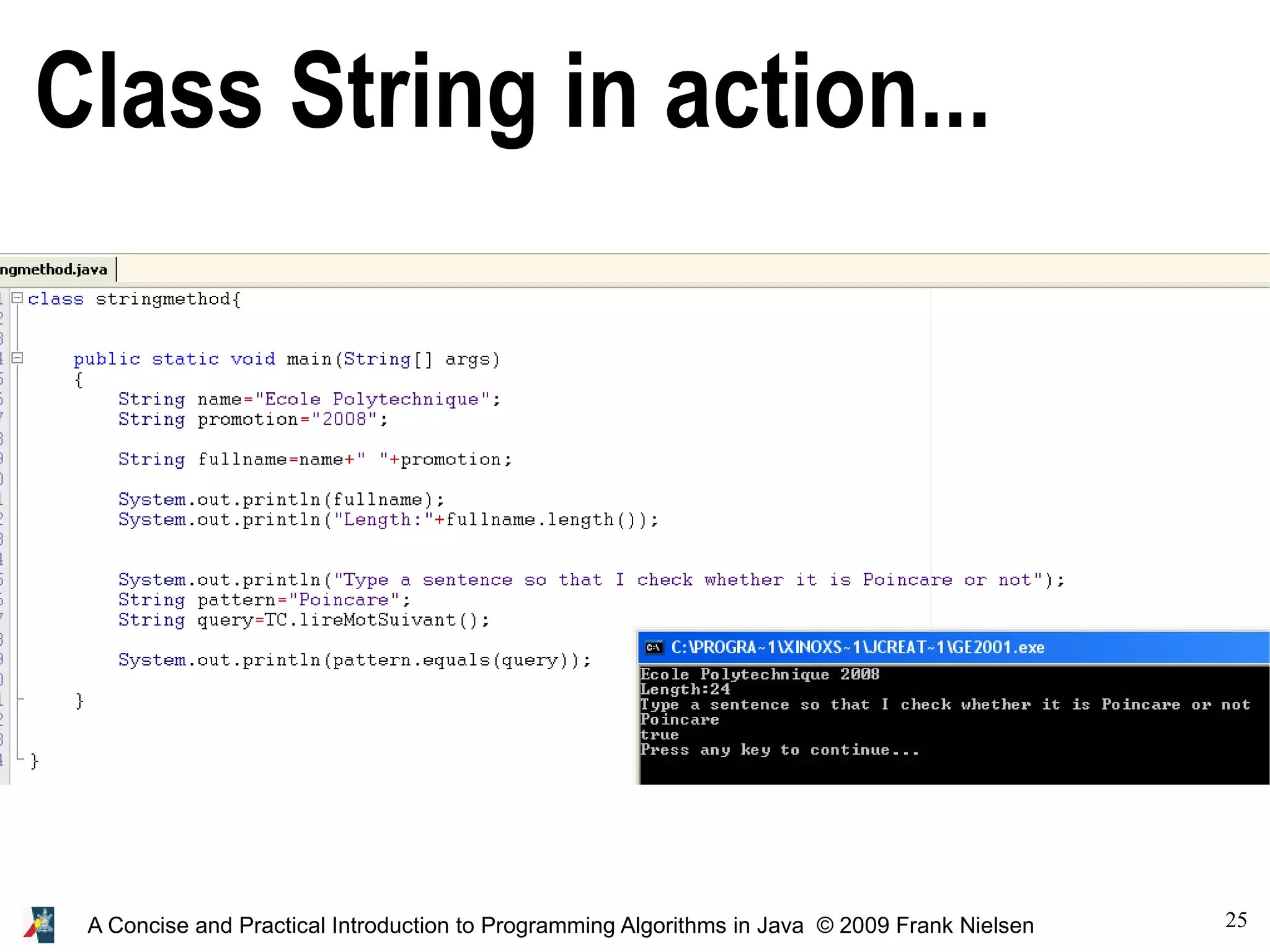
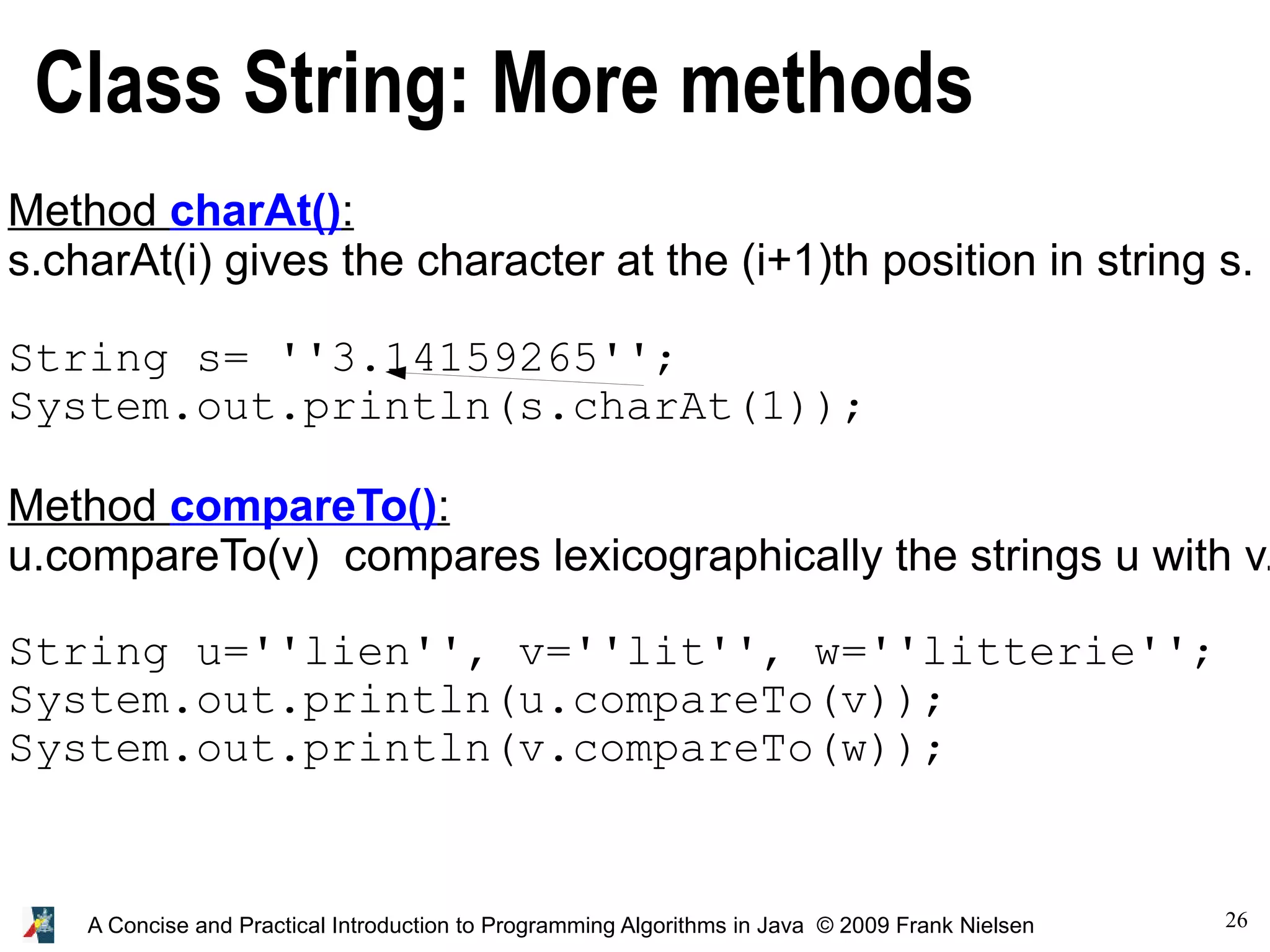
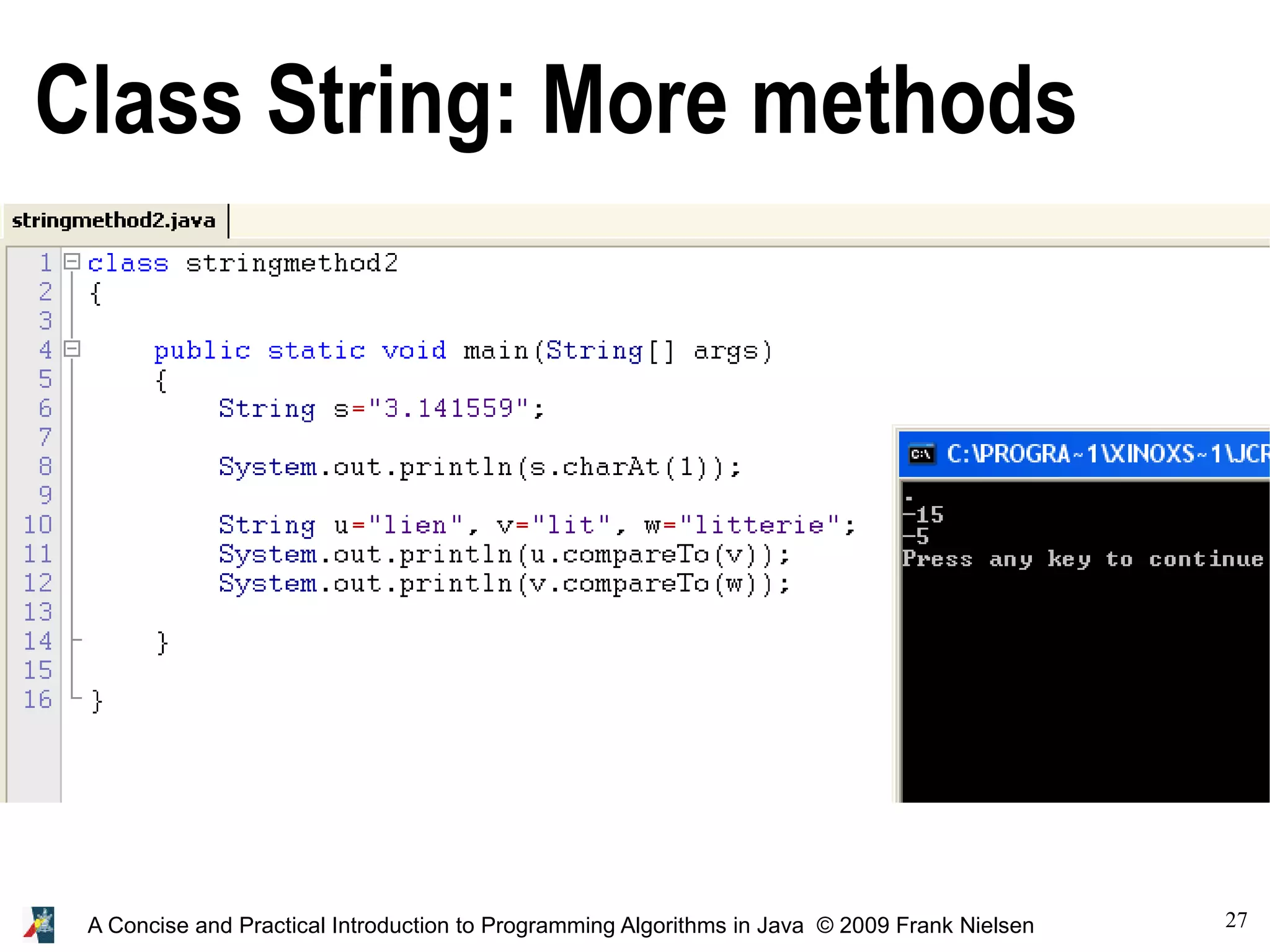
![28A Concise and Practical Introduction to Programming Algorithms in Java © 2009 Frank Nielsen Demystifying the main function class ClassName { public static void main(String[ ] args) { ... } } Function main has an array of string of characters as arguments These strings are stored in args[0], args[1], ... ... when calling java main s0 s1 s2 s3 Use Integer.parseInt() to convert a string into an integer](https://image.slidesharecdn.com/programmingalgorithmsjava-4-140701005341-phpapp02/75/chapter-4-A-Concise-and-Practical-Introduction-to-Programming-Algorithms-in-Java-28-2048.jpg)
